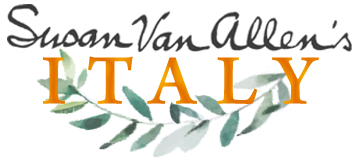 Palermo is a city of so many fascinating layers, that the best way to experience it is to have a savvy local by your side. Here’s where Passage to Sicily comes in. It’s an association that offers small group tours all over Sicily for culturally curious travelers, led by scholars, writers, and architects who bring their unique insights into Sicilian life and culture. My Roman friend, the wonderful Petulia Melideo of Context Travel, highly recommends Passage to Sicily–and since my experiences on walking tours with Context in Rome, Florence, Venice, and Naples have been so amazing, I’m glad to know that a similar organization exists for my next trip to Sicily.
Palermo is a city of so many fascinating layers, that the best way to experience it is to have a savvy local by your side. Here’s where Passage to Sicily comes in. It’s an association that offers small group tours all over Sicily for culturally curious travelers, led by scholars, writers, and architects who bring their unique insights into Sicilian life and culture. My Roman friend, the wonderful Petulia Melideo of Context Travel, highly recommends Passage to Sicily–and since my experiences on walking tours with Context in Rome, Florence, Venice, and Naples have been so amazing, I’m glad to know that a similar organization exists for my next trip to Sicily.
I am thrilled that one of Passage to Sicily’s founders, Caroline Chaumont, a journalist who lives in Palermo, now generously shares with us her Golden Day strolling through Palermo’s markets:
 All senses out ! Palermo has fantastic food and wonderfulmarkets. They spread in the oldest neighborhoods of the city which also hosts some magnificent baroque churches.
All senses out ! Palermo has fantastic food and wonderfulmarkets. They spread in the oldest neighborhoods of the city which also hosts some magnificent baroque churches.
It is better to visit them in the morning when the hustle is at its highest and churches are opened.
One of the most popular markets is The Capo. Access is through Porta Carini, one of the ancient city gates, near the Court House.
The Capo sprawls along a single street with colorful stalls flanking it.  Variety is the key word: tomatoes of all sizes and shapes, purple-green artichokes, wild asparagus and fennel, juicy oranges and lemons, shinny eggplants, and, of course, lots and lots of olives. In some ways, the markets remind me of an Arabic souk.
Variety is the key word: tomatoes of all sizes and shapes, purple-green artichokes, wild asparagus and fennel, juicy oranges and lemons, shinny eggplants, and, of course, lots and lots of olives. In some ways, the markets remind me of an Arabic souk.
 Don’t miss the first fish stall on the right, with boxes brimming with tiny sardines, large tuna and swordfish, squid and red prawns. The Isgro family prepares fish specialties such as the polpette di sarde, (sardine balls). Fish sells quickly there. It is the freshest, some say.
Don’t miss the first fish stall on the right, with boxes brimming with tiny sardines, large tuna and swordfish, squid and red prawns. The Isgro family prepares fish specialties such as the polpette di sarde, (sardine balls). Fish sells quickly there. It is the freshest, some say.
For snacks, I recommend the “Friggitoria” of Arianna, further along the street next to number 53. You should try the arancini (deep-fried risotto balls), panelle (chickpea fritters) and sfincione (a type of deep pizza with tomatoes, onions and anchovies). Palermo is famous for its street fare, simple and popular foods that one eats on the spot. For a more substantive lunch, try the Trattoria Supra I Mura (piazetta Porta Carini,5).
Further along, stop at the Anticha Drogheria di Dainotti. You’ll find heaps of spices, dried oregano and tomatoes, pepper, grassy-green olive oil, capers packed in salt (try the ones from Pantelleria island which are the best) and pine nuts. And indulge yourself with some fresh pistachios grown in Bronte, on the slopes of Mount Etna.
Another few stalls and there stands Angelo, an old man who sells dried sardines, an essential ingredient for the broccoli tegame (pasta with cauliflower).
 Angelo’s stall faces one of Palermo’s most spectacular baroque churches, the 17th century Immacolata Concezione (9 am-12pm). The breathtaking interior is carpeted with polychrome marble decorations, typical of Sicilian Baroque. There is no space free of marble!
Angelo’s stall faces one of Palermo’s most spectacular baroque churches, the 17th century Immacolata Concezione (9 am-12pm). The breathtaking interior is carpeted with polychrome marble decorations, typical of Sicilian Baroque. There is no space free of marble!
I love the way the market and the church decorations mirror each other with color and sensuality.
Check out the Liberty mosaics at the Bakery Morello. Next to it, a stall offers many varieties of olives, brine-cured or marinated with lemon, rosemary or spices.
 Walk down to San Agostino Church (at the intersection of Via S. Agostino and Via Spirito Santo,
Walk down to San Agostino Church (at the intersection of Via S. Agostino and Via Spirito Santo,
and open daily from 7 to 12 am) and its stupendous stone rose. Worth noting are the eight superb statues of Agostinian saints sculpted by GiacomoSerpotta, a leading master of stucco sculpting of late Baroque.
 Palermo is a great city for coffee, cakes and pastries lovers. Traditionally, pastries were prepared by nuns. If you need a ‘sweet break’, try Da Bobbuccio, a popular bar (Via PortaCarini, 67. 091589802).
Palermo is a great city for coffee, cakes and pastries lovers. Traditionally, pastries were prepared by nuns. If you need a ‘sweet break’, try Da Bobbuccio, a popular bar (Via PortaCarini, 67. 091589802).
If you are looking for a somewhat elegant place, go to the famous writers’ café Mazzara, about five minutes walk from Porta Carini (Via Generale Vincenzo Maglioco, 11 – 091 321443). You can indulge yourself with cannoli or pistachio ice-cream.
 Another historic market to stroll is Ballaro, which dates back to the Middle Ages. It is located in the Albergheria, a vibrant neighborhood where many foreign communities now live. Crumbling sumptuously decorated aristocratic palaces are reminders of its glorious past.
Another historic market to stroll is Ballaro, which dates back to the Middle Ages. It is located in the Albergheria, a vibrant neighborhood where many foreign communities now live. Crumbling sumptuously decorated aristocratic palaces are reminders of its glorious past.
The Jesuit Church del Jesu(Piazza Casa Professa), Palermo’s most important Baroque church, is a good starter to your market stroll. You can also admire the Dome of the Carmine Church (Piazza del Carmine – open daily 9 -12 am), covered with Sicilian ceramic tiles, that’s close by. Its entrance is hidden behind colorful food stalls. Inside you can admire Serpotta’s sculpture and the rich decoration of the columns, which illustrate the Passion, with wonderful details.
Its entrance is hidden behind colorful food stalls. Inside you can admire Serpotta’s sculpture and the rich decoration of the columns, which illustrate the Passion, with wonderful details.
I recommend staying at Le Terrazze, a splendid B&B which boasts a series of terraces with a 360° view of the city.  The B&B is a palazzo built in the 18th century, and many of its furniture is original. Its central location is ideal.
The B&B is a palazzo built in the 18th century, and many of its furniture is original. Its central location is ideal.
Grazie Caroline–I’m salivating and ready to return to Palermo!




Giuliano and I were fortunate to stay in Taormina and enjoy Sicily. Unfortunately, the weather was poor and we were unable to get to Palermo, we actually got stuck in a snow storm. I’d love the chance to go back to Sicily and see that great city. The food market descriptions have me salivating!
My parents are origanally from Palermo and I remember hearing all the places mentioned in you article in their general conversations. As a teenager I traveled to Palermo and visited all the places mentioned, however Icould not appreciate it’s significance until I traveled there recently with my youngest son. I went shopping at Balaro and “U Capu” for our meals and remembering the conversations my uncle and dad, who have since passed had with my mom made me miss them even more. It was a sureal experience imagining them walking where I had just passed. And I know that it has not changed in all the years… Thank you…
Thank you for sharing this wonderful experience. I feel the same way when I visit places I remember hearing my grandparents talk about–in Naples, Molise, and Potenza–it really brings them close to me and I’m always grateful to them for inspiring my travels to Italy.
Hi Susan,
I was just reading your book and realized that your nana’s hometown is only a few towns away from my dad’s hometown of Castropignano! Molise is just so beautiful (and undiscovered)!
Wishing you a happy spring.
Jaime
P.S. I adore the markets and panelle in Palermo!
Wow–I’ve met so many Molisani over here—most of them, like you, have relatives from my nana’s neighborhood! In fact some of my Vinchiaturo cousins ending up going to Canada, then Chicago. It is really a lovely, undiscovered place. I look forward to spending more time there. Grazie for being in touch! Wishing you a happy spring and I hope you get back to Italy soon!